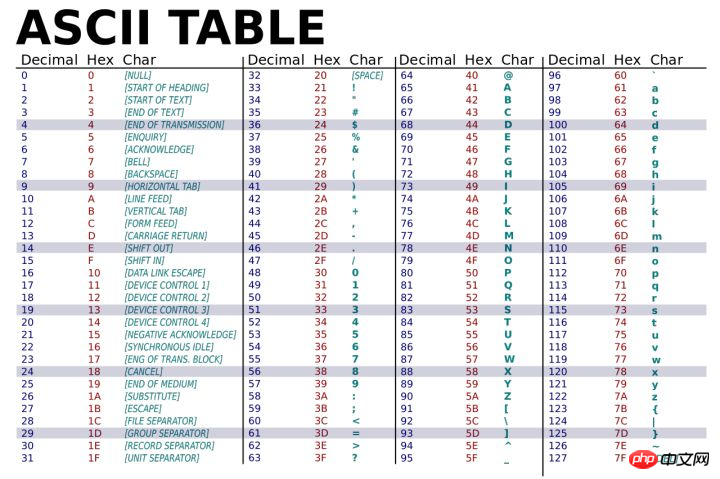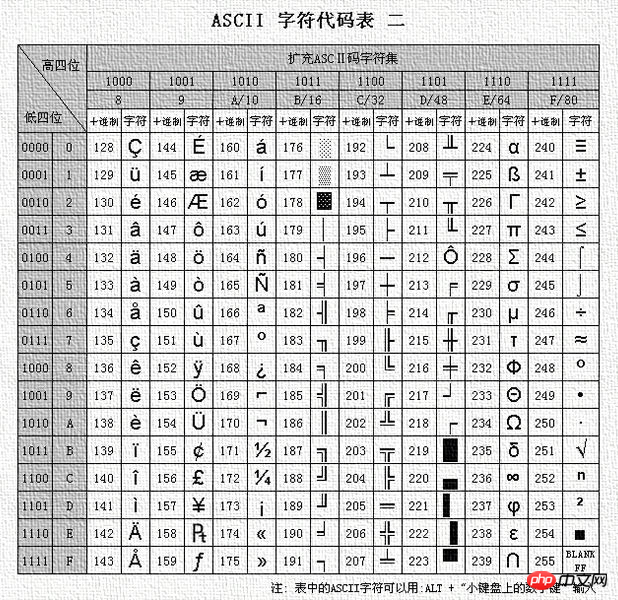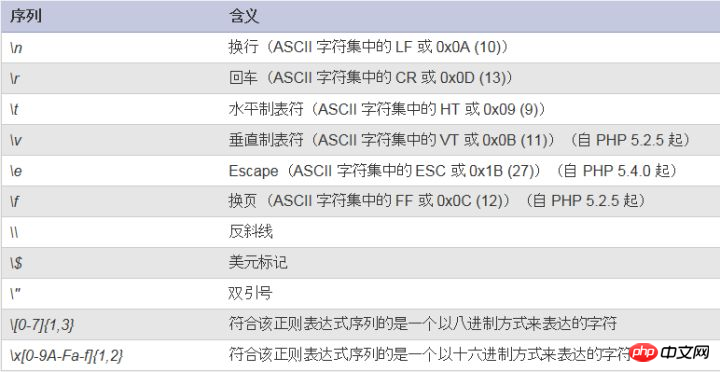PHP basic syntax summary
The best thing for those who have weak basic knowledge of PHP is to review the basics again, but when we look at the basics of PHP, we feel that it is too simple and we can’t understand it at all. I believe many students have had such an experience, so let’s Let’s take a look at this summary of basic PHP syntax!
1. Code identification PHP Tag
►Recommended format
►Short tag format ?>
※To use short tags, you need to modify PHP.ini->short_open_tag and restart apache
※Pure PHP code page, the end tag can be omitted "?>" is best deleted at the end of the file. This prevents accidentally added spaces or newlines from being output after the PHP closing tag.
2 Instruction separation character ";" Enter below.
3. Access method
php files cannot be opened directly and must be accessed through domain names or IP addresses. No Chinese characters can be included in the PHP file name or path!
4. Comments
►Single-line comments//Comment content (C++ style)
#Comment content (Unix Shell style)
►Multi-line comments
/*Comment content*/(C style)
※Do not wrap comments with comments
※Comments can temporarily disable the code
※Single-line comments only comment to the end of the line or the current PHP code block, which means after // ... ?> or # ... ?> The HTML code will be displayed, such as:
<h1>
This is an <?php # echo 'simple'; ?> example
</h1>5. Case Sensitity
►PHP variables are case sensitive; ►PHP language keywords, functions, custom classes and functions are not partitioned;
6. Blank Whitespace
refers to Characters without content, such as spaces, tabs, newline characters
The spaces between PHP statements will be ignored by the PHP engine.
7. Literals
Literals refer to data that can be written directly in the program, such as: 2018, 1.3, true, ' Hello May'
8. Identifier
Identifier is used to name variables, constants, functions and classes, the first character of the name It must be an ASCII letter (both upper and lower case), an underscore, or any one of the ASCII character sets 127 to 255. Only numbers and other above-mentioned characters can be used for the second character.
ASCII character set 0-127
 9. Language keywords Keywords
9. Language keywords Keywords
can also be called reserved words, which are pre-set to implement the core functions of the language. They are not case-sensitive. The names of variables, methods, etc. cannot have the same name as them. Common ones are: echo, const, if, print, return, newIn addition, PHP
built-in functionscannot have the same name as
custom functions. 10. Single and double quotes
When single quotes contain variables,
variables are represented as strings Format output.When double quotes contain variables,
variables are parsed and the value is output;※In single quote strings, only Single quotes and backslashes will be treated specially.
Single quotes embedded in double quotes
$str = 'Jax said: "2017, thank you for having you"'
Double quotes embedded Single quotes$str = "'When I rise, I will repay you'"; can also be single-embedded or double-embedded double
11. Escape
Some characters will be "specially treated" by the PHP parsing engine, so writing them needs to be escaped. To escape the characters, add the backslash "\". Just before the characters that need to be escaped, such as: echo "\"The upper part is the hall, the lower part is the kitchen, type the code, and detect the exception\""
Other conversions The defined characters are as follows:
Regular expression is a custom rule for querying and retrieving a specified string. Regular expressions are the basis, right? But regular expressions are not that easy to understand.
is a custom rule for querying and retrieving a specified string. Regular expressions are the basis, right? But regular expressions are not that easy to understand.
Review and consolidate the foundation:
php basic knowledge note sharing php basic knowledge summary (necessary for novices) php basics: custom functions Detailed explanation of usage examples
The above is the detailed content of PHP basic syntax summary. For more information, please follow other related articles on the PHP Chinese website!

Hot AI Tools

Undresser.AI Undress
AI-powered app for creating realistic nude photos

AI Clothes Remover
Online AI tool for removing clothes from photos.

Undress AI Tool
Undress images for free

Clothoff.io
AI clothes remover

Video Face Swap
Swap faces in any video effortlessly with our completely free AI face swap tool!

Hot Article

Hot Tools

Notepad++7.3.1
Easy-to-use and free code editor

SublimeText3 Chinese version
Chinese version, very easy to use

Zend Studio 13.0.1
Powerful PHP integrated development environment

Dreamweaver CS6
Visual web development tools

SublimeText3 Mac version
God-level code editing software (SublimeText3)

Hot Topics
 1664
1664
 14
14
 1423
1423
 52
52
 1318
1318
 25
25
 1269
1269
 29
29
 1248
1248
 24
24
 Explain JSON Web Tokens (JWT) and their use case in PHP APIs.
Apr 05, 2025 am 12:04 AM
Explain JSON Web Tokens (JWT) and their use case in PHP APIs.
Apr 05, 2025 am 12:04 AM
JWT is an open standard based on JSON, used to securely transmit information between parties, mainly for identity authentication and information exchange. 1. JWT consists of three parts: Header, Payload and Signature. 2. The working principle of JWT includes three steps: generating JWT, verifying JWT and parsing Payload. 3. When using JWT for authentication in PHP, JWT can be generated and verified, and user role and permission information can be included in advanced usage. 4. Common errors include signature verification failure, token expiration, and payload oversized. Debugging skills include using debugging tools and logging. 5. Performance optimization and best practices include using appropriate signature algorithms, setting validity periods reasonably,
 PHP Program to Count Vowels in a String
Feb 07, 2025 pm 12:12 PM
PHP Program to Count Vowels in a String
Feb 07, 2025 pm 12:12 PM
A string is a sequence of characters, including letters, numbers, and symbols. This tutorial will learn how to calculate the number of vowels in a given string in PHP using different methods. The vowels in English are a, e, i, o, u, and they can be uppercase or lowercase. What is a vowel? Vowels are alphabetic characters that represent a specific pronunciation. There are five vowels in English, including uppercase and lowercase: a, e, i, o, u Example 1 Input: String = "Tutorialspoint" Output: 6 explain The vowels in the string "Tutorialspoint" are u, o, i, a, o, i. There are 6 yuan in total
 Explain late static binding in PHP (static::).
Apr 03, 2025 am 12:04 AM
Explain late static binding in PHP (static::).
Apr 03, 2025 am 12:04 AM
Static binding (static::) implements late static binding (LSB) in PHP, allowing calling classes to be referenced in static contexts rather than defining classes. 1) The parsing process is performed at runtime, 2) Look up the call class in the inheritance relationship, 3) It may bring performance overhead.
 What are PHP magic methods (__construct, __destruct, __call, __get, __set, etc.) and provide use cases?
Apr 03, 2025 am 12:03 AM
What are PHP magic methods (__construct, __destruct, __call, __get, __set, etc.) and provide use cases?
Apr 03, 2025 am 12:03 AM
What are the magic methods of PHP? PHP's magic methods include: 1.\_\_construct, used to initialize objects; 2.\_\_destruct, used to clean up resources; 3.\_\_call, handle non-existent method calls; 4.\_\_get, implement dynamic attribute access; 5.\_\_set, implement dynamic attribute settings. These methods are automatically called in certain situations, improving code flexibility and efficiency.
 PHP and Python: Comparing Two Popular Programming Languages
Apr 14, 2025 am 12:13 AM
PHP and Python: Comparing Two Popular Programming Languages
Apr 14, 2025 am 12:13 AM
PHP and Python each have their own advantages, and choose according to project requirements. 1.PHP is suitable for web development, especially for rapid development and maintenance of websites. 2. Python is suitable for data science, machine learning and artificial intelligence, with concise syntax and suitable for beginners.
 PHP in Action: Real-World Examples and Applications
Apr 14, 2025 am 12:19 AM
PHP in Action: Real-World Examples and Applications
Apr 14, 2025 am 12:19 AM
PHP is widely used in e-commerce, content management systems and API development. 1) E-commerce: used for shopping cart function and payment processing. 2) Content management system: used for dynamic content generation and user management. 3) API development: used for RESTful API development and API security. Through performance optimization and best practices, the efficiency and maintainability of PHP applications are improved.
 PHP: A Key Language for Web Development
Apr 13, 2025 am 12:08 AM
PHP: A Key Language for Web Development
Apr 13, 2025 am 12:08 AM
PHP is a scripting language widely used on the server side, especially suitable for web development. 1.PHP can embed HTML, process HTTP requests and responses, and supports a variety of databases. 2.PHP is used to generate dynamic web content, process form data, access databases, etc., with strong community support and open source resources. 3. PHP is an interpreted language, and the execution process includes lexical analysis, grammatical analysis, compilation and execution. 4.PHP can be combined with MySQL for advanced applications such as user registration systems. 5. When debugging PHP, you can use functions such as error_reporting() and var_dump(). 6. Optimize PHP code to use caching mechanisms, optimize database queries and use built-in functions. 7
 The Enduring Relevance of PHP: Is It Still Alive?
Apr 14, 2025 am 12:12 AM
The Enduring Relevance of PHP: Is It Still Alive?
Apr 14, 2025 am 12:12 AM
PHP is still dynamic and still occupies an important position in the field of modern programming. 1) PHP's simplicity and powerful community support make it widely used in web development; 2) Its flexibility and stability make it outstanding in handling web forms, database operations and file processing; 3) PHP is constantly evolving and optimizing, suitable for beginners and experienced developers.




